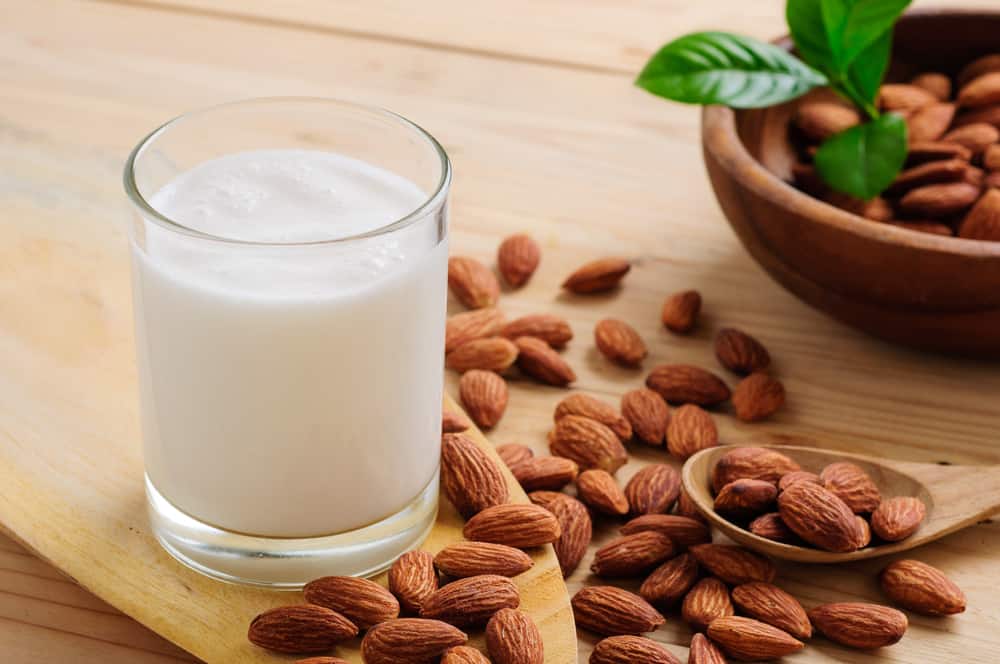The unofficial trademark of vegans everywhere, almond milk is arguably the most popular non-dairy milk available today.
Made solely from almonds, sweeteners, and thickening agents, almond milk is also an excellent choice for people with lactose intolerance or milk allergies.
Although almond milk is not nearly as nutritious as cow’s milk, it is no pushover either. Many brands come infused with minerals and nutrients that provide you additional health benefits. Typical almond milk fortification includes vitamin E and calcium
However, for the uninitiated, figuring out the shelf life, and how to store or refrigerate almond milk can be confusing at first. A key contributor to this confusion is that almond typically ships in two varieties: refrigerated variants and shelf-stable unrefrigerated versions.
Contents
Does Almond Milk Go Bad?
Yes, both refrigerated and unrefrigerated almond milk will go bad eventually. The spoilage process is further accelerated if an already opened milk container is left unrefrigerated.
However, each type of almond milk has different shelf lives, usage instructions, and storage requirements.
Nevertheless, one constant for both types of almond milk is that the quality deteriorates rapidly if a pack is left open at room temperature. Leaving the milk container out for a couple of hours is typically okay. However, anything significantly above that will most likely lead to spoilage.
Furthermore, when storing almond milk in the fridge, manufacturers recommend that you place it inside the main bowl of the refrigerator as opposed to any of the door rungs. As almond milk is susceptible to warm temperatures, temperature fluctuations in the door area can accelerate spoilage.
Refrigerated Almond Milk
Refrigerated almond milk is the most fragile of the pair. This type of almond milk must be in a fridge at all times. With this almond milk variant, leaving a pack unrefrigerated for a few hours is enough to spoil the milk and make it unsafe for consumption.
According to Blue Diamond, a premier almond milk manufacturer, you should store refrigerated almond milk at 1 to 6°C up until the Use-By date.
However, once you open the container, you must consume the content within 7-10 days, while keeping the package sealed tightly and refrigerated when not in use.
Unlike many shelf-stable options, refrigerated almond milk brand typical use a Use-By date instead of a Best-Before date. Use-By dates connote a stricter recommendation and a potential for hazardous consequences if ignored. Hence, for safety reasons, and best quality, we recommend consuming refrigerated almond milk by the prescribed date.
Shelf-Stable Almond Milk
Shelf-stable (or unrefrigerated) almond milk, on the other hand, is a variant that can sit at room temperature for extended periods. However, this directive only applies to an unopened carton.
Like with refrigerated almond milk, opened containers of shelf-stable variants must be sealed tightly and kept refrigerated to avoid spoilage. Opened packages can last for up to 7-10 days under constant refrigeration.
Unlike the refrigerated variants, however, shelf-stable almond milk typically comes with a best before date. Hence, this type of almond milk is usually still fit for consumption after the recommended date, albeit not for longer than 2 to 4 weeks.
Homemade Almond Milk
If you make, almond milk at home, you should consume each batch within 3 to 4 days. Furthermore, you must keep the milk refrigerated at all time.
The reason for this relatively short storage allowance is because homemade milk is unpasteurized. Store-bought variants, on the other hand, can typically last for way longer thanks to being ultra-pasteurized.
Pasteurization is a process during which almond milk is heated to at least 280°F for a few seconds before being packaged. This process kills all the bacteria in the milk and as a result, significantly increases its shelf life.
However, pasteurization also kills good bacteria—that are a positive addition to our gut biome with the bad. Hence, many purists and health enthusiasts opt for homemade almond milk instead.
Can You Freeze Almond Milk?
Yes and No.
If you plan to drink almond milk, you may want to skip the freezer. This is because after freezing, almond milk does not thaw back into the same consistent liquid you started with. The resultant unfrozen is often quite irregular, reducing palatability and visual appeal. Consequently, many manufacturers do not recommend freezer storage for their products.
However, if your primary use case is baking, freezing leftovers can be an excellent strategy for preserving portions and preventing waste. Freezing works because using dethawed almond milk typical works as good as regular almond milk in baking or cooking recipes. In such dishes, the change of texture is usually unnoticeable, and it does not affect the quality of the end product.
How to Tell if Almond Milk has Gone Bad?
The telltale sign of spoilt almond milk is an unusually bloated tetra carton. If you notice any bloating on the packaging, it’s probably time to get a new batch.
Furthermore, during use, if you notice any unusual smells, any lumps or discolorations in the liquid, discard the milk package to avoid any health risks.
However, even if your almond milk pack looks fine, you should take the age of the batch into consideration.
Since the initial signs of spoilage are almost impossible to spot, you may be drinking spoiled milk if the pack is already more than three months past the best-by date. In such a case, to avoid food poisoning, its best to cut your losses and order a new batch.
More:
